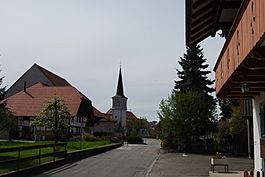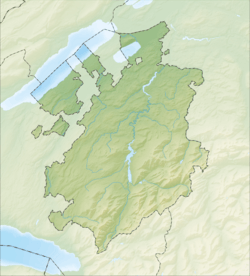Gurmels facts for kids
Quick facts for kids
Gurmels
|
||
|---|---|---|

Gurmels
|
||
|
||
| Country | Switzerland | |
| Canton | Fribourg | |
| District | See | |
| Area | ||
| • Total | 17.34 km2 (6.70 sq mi) | |
| Elevation | 542 m (1,778 ft) | |
| Population
(Dec 2020 )
|
||
| • Total | 4,487 | |
| • Density | 258.77/km2 (670.20/sq mi) | |
| Postal code |
3212
|
|
| Surrounded by | Barberêche, Courtepin, Cressier, Düdingen, Ferenbalm (BE), Staatswald Galm, Jeuss, Kleinbösingen, Kriechenwil (BE), Laupen (BE), Ulmiz, Wallenried | |
Gurmels (German) or Cormondes is a municipality in Switzerland. It is located in the canton of Fribourg, within the See district. Gurmels is special because it sits right on the language border between German and French.
Over the years, Gurmels has grown bigger by joining with several smaller villages. For example, the village of Cordast became part of Gurmels in January 2005.
Contents
A Look at Gurmels' Past
Gurmels was first mentioned in old documents in 1186. Back then, it was called Cormulnes. Later, in 1228, it was known as Cormunec, and in 1242 as Cormugnes.
From the 15th century onwards, people started calling it Cormondes. The German name, Gurmols, first appeared in 1240. This shows how the name changed over many centuries.
Where is Gurmels? (Geography)
Gurmels covers an area of about 17.3 square kilometers (6.7 square miles). A large part of this land, about 68.6%, is used for farming. This means there are many fields for growing crops and pastures for animals.
About 20% of the area is covered by forests. The rest of the land, about 10.4%, has buildings and roads. A small part, 0.6%, includes rivers and lakes.
How Gurmels Grew
Gurmels is located about 10 kilometers (6 miles) north of Fribourg. It's right on the border where German and French are spoken. The main village of Gurmels is a haufendorf, which means it's an old village with an irregular, unplanned shape, built around a central area.
Gurmels has grown by merging with other nearby municipalities. In 1978, Monterschu and Grossgurmels joined together to form Gurmels. Kleingurmels also merged with Gurmels in 2000. Before that, these two had been managed together for a long time, from 1880 to 1982.
More villages joined later:
- In 2003, Guschelmuth (Courchelmont), Liebistorf, and Wallenbuch became part of Gurmels.
- Then, in 2005, Cordast also joined the municipality.
Gurmels' Coat of Arms
Every town has a special symbol called a coat of arms. It's like a unique picture that represents the municipality. Gurmels' coat of arms is divided into two parts.
The top part is silver and shows half of a red lion standing up. The bottom part is blue and features a silver ploughshare, which is the main cutting blade of a plough used in farming.
Who Lives in Gurmels? (Demographics)
Gurmels has a population of around 4,000 people. About 6.2% of the people living here are from other countries. Over the last ten years (2000–2010), the population grew by about 15.8%. Most of this growth came from people moving to Gurmels.
Languages Spoken
Gurmels is mainly a German-speaking municipality. This is interesting because the canton of Fribourg, where Gurmels is located, is mostly French-speaking.
In 2000, most people (93.4%) spoke German as their main language. French was the second most common language (3.9%), followed by Italian (0.9%).
Where People Were Born
In 2000, about 36.6% of the people living in Gurmels were born there. Another 30% were born in the same canton of Fribourg. About 22.4% were born somewhere else in Switzerland, and 6.6% were born outside of Switzerland.
Age Groups
In 2000, the population of Gurmels included:
- Children and teenagers (0–19 years old): 28.9%
- Adults (20–64 years old): 60.5%
- Seniors (over 64 years old): 10.6%
Households in Gurmels
In 2000, there were 1,192 private households in Gurmels, with an average of 2.7 people per household. Most apartments (91.9%) were lived in all year round.
The historical population is shown in the chart below:

How People Work in Gurmels (Economy)
In 2010, the unemployment rate in Gurmels was low, at 1.8%. This means most people who wanted to work had jobs.
Types of Jobs
In 2008, there were 545 full-time jobs in Gurmels. These jobs were spread across different types of industries:
- Primary Sector: This includes jobs related to nature, like farming and forestry. There were 111 jobs in this sector.
- Secondary Sector: This involves making things, like in factories or construction. There were 199 jobs in this sector. About 35% were in manufacturing and 64% in construction.
- Tertiary Sector: This covers service jobs, like working in shops, hotels, schools, or healthcare. There were 235 jobs in this sector. For example, many people worked in sales, transportation, restaurants, education, and healthcare.
Commuting to Work
In 2000, 161 people traveled into Gurmels for work, while 550 people who lived in Gurmels traveled to other places for their jobs. This means more people leave Gurmels for work than come in.
Most people (69.7%) used a private car to get to work, while 7.9% used public transportation.
Faith and Beliefs (Religion)
In 2000, people in Gurmels followed different religions:
- Most people (64.6%) were Roman Catholic.
- About 23.9% belonged to the Swiss Reformed Church (a type of Protestant church).
- A smaller number of people belonged to other Christian churches, or were Islamic or Buddhist.
- Some people (4.4%) did not belong to any church or had no specific religion.
Learning and Schools (Education)
Education is very important in Gurmels. In 2000, about 39.1% of the population had finished high school (upper secondary education). Also, 9.4% had gone on to higher education, like university or a specialized college.
The School System in Fribourg
The school system in the canton of Fribourg works like this:
- Kindergarten: One year of non-mandatory kindergarten.
- Primary School: Six years of primary school.
- Lower Secondary School: Three years of mandatory lower secondary school. Students are grouped based on their abilities.
- Upper Secondary School: After lower secondary, students can choose to go to an optional three or four-year upper secondary school. This can be a gymnasium (which prepares students for university) or a vocational program (which teaches job skills).
- Tertiary School: After upper secondary, students can go to university or continue with an apprenticeship (learning a trade on the job).
Students in Gurmels
During the 2010–11 school year, 634 students attended classes in Gurmels. In total, 715 students from Gurmels attended school either in the municipality or elsewhere.
- There were 5 kindergarten classes with 108 students.
- There were 16 primary classes with 330 students.
- There were 11 lower secondary classes with 196 students.
Some students from Gurmels went to schools in other municipalities for upper secondary or tertiary education.
See also
 In Spanish: Gurmels para niños
In Spanish: Gurmels para niños





